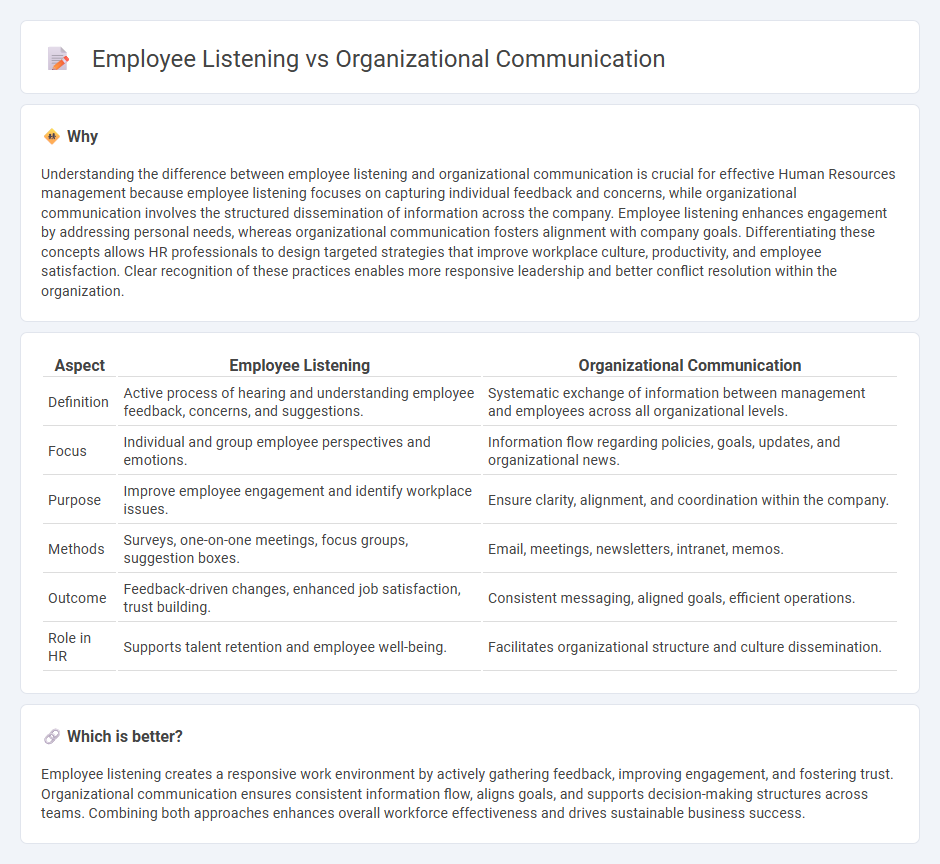
Employee listening focuses on capturing and understanding workers' feedback, concerns, and sentiments to enhance workplace engagement and satisfaction. Organizational communication encompasses the structured flow of information across all levels, facilitating clarity, alignment, and effective decision-making within the company. Explore the key differences and benefits of employee listening versus organizational communication to optimize your HR strategy.
Why it is important
Understanding the difference between employee listening and organizational communication is crucial for effective Human Resources management because employee listening focuses on capturing individual feedback and concerns, while organizational communication involves the structured dissemination of information across the company. Employee listening enhances engagement by addressing personal needs, whereas organizational communication fosters alignment with company goals. Differentiating these concepts allows HR professionals to design targeted strategies that improve workplace culture, productivity, and employee satisfaction. Clear recognition of these practices enables more responsive leadership and better conflict resolution within the organization.
Comparison Table
| Aspect | Employee Listening | Organizational Communication |
|---|---|---|
| Definition | Active process of hearing and understanding employee feedback, concerns, and suggestions. | Systematic exchange of information between management and employees across all organizational levels. |
| Focus | Individual and group employee perspectives and emotions. | Information flow regarding policies, goals, updates, and organizational news. |
| Purpose | Improve employee engagement and identify workplace issues. | Ensure clarity, alignment, and coordination within the company. |
| Methods | Surveys, one-on-one meetings, focus groups, suggestion boxes. | Email, meetings, newsletters, intranet, memos. |
| Outcome | Feedback-driven changes, enhanced job satisfaction, trust building. | Consistent messaging, aligned goals, efficient operations. |
| Role in HR | Supports talent retention and employee well-being. | Facilitates organizational structure and culture dissemination. |
Which is better?
Employee listening creates a responsive work environment by actively gathering feedback, improving engagement, and fostering trust. Organizational communication ensures consistent information flow, aligns goals, and supports decision-making structures across teams. Combining both approaches enhances overall workforce effectiveness and drives sustainable business success.
Connection
Employee listening enhances organizational communication by creating feedback loops that promote transparency and trust within the workplace. Effective communication channels encourage employees to share insights, which leads to more informed decision-making and higher engagement levels. This connection helps organizations adapt quickly to employee needs, boosting productivity and overall job satisfaction.
Key Terms
**Organizational Communication:**
Organizational communication encompasses the structured exchange of information within a company, involving formal channels such as meetings, reports, and digital platforms that facilitate coordination and decision-making among departments. Effective organizational communication enhances transparency, aligns team objectives, and supports corporate culture development, leading to improved overall performance and employee engagement. Explore deeper insights into how organizational communication strategies can transform workplace dynamics and foster a productive environment.
Information Flow
Organizational communication encompasses the structured exchange of information between various levels and departments, facilitating efficient workflows and decision-making processes. Employee listening focuses on capturing and responding to feedback from staff, enhancing engagement and fostering a two-way communication flow that supports organizational success. Explore strategies to optimize both organizational communication and employee listening for improved information flow within your company.
Channels
Organizational communication often relies on formal channels like intranets, emails, and meetings to disseminate information efficiently across departments. Employee listening emphasizes interactive channels such as surveys, focus groups, and open forums that facilitate two-way dialogue and feedback collection. Explore more strategies to enhance your organization's communication effectiveness and employee engagement.
Source and External Links
5 Dimensions of Organizational Communication | HBS Online - Organizational communication broadly describes how a firm's information is shared internally and externally, including newsletters, meetings, and social media, and emphasizes clear, compelling, and concise communication to align and motivate teams.
What Is Organizational Communication? (Types and Importance) - Organizational communication covers all communication used by a company, involving various stakeholders like CEOs, HR teams, managers, and employees to ensure a unified message and effective information flow internally and externally.
Organizational communication - Wikipedia - Organizational communication involves the exchange of information among individuals and groups within an organization to support functioning, addressing human aspects such as motivation, conflict resolution, and adapting to remote work environments.
 dowidth.com
dowidth.com